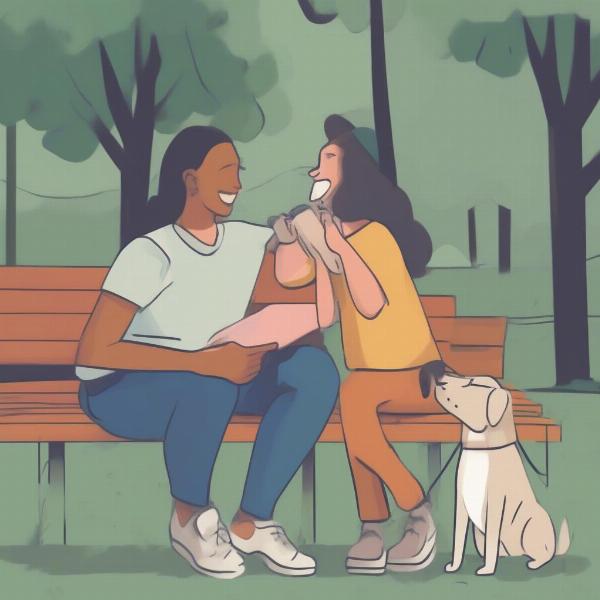The term “goodboy dog” is often used affectionately to describe well-behaved and lovable canines. But what makes a dog a “goodboy”? It’s more than just following commands; it’s about the unique bond between humans and dogs, built on mutual respect, understanding, and love. This article explores the various facets of what makes a dog a “goodboy,” from training and behavior to the special connection they share with their human companions.
Understanding your dog’s individual needs and personality is crucial in nurturing their “goodboy” qualities. Every dog is unique, with their own quirks and preferences. Some breeds are naturally more inclined towards certain behaviors, while others require more patience and consistent training. A dog’s upbringing, socialization, and environment also play a significant role in shaping their personality and behavior. Whether you have a playful puppy or a seasoned senior, understanding their specific needs is the first step towards fostering a strong and positive relationship.
Nurturing the “Goodboy” Within: Training and Socialization
Training is essential in developing a well-behaved dog, laying the foundation for a harmonious relationship. Positive reinforcement methods, such as rewarding desired behaviors with treats and praise, are generally more effective than punishment-based techniques. Consistency is key; establish clear rules and boundaries from the beginning, and stick to them. Start with basic commands like sit, stay, and come, gradually progressing to more complex tasks.
Socialization is just as important as training. Expose your dog to various sights, sounds, and experiences from a young age, including interactions with other dogs and people. Proper socialization helps them develop confidence and adapt to different environments, minimizing the risk of fear-based aggression or anxiety later in life.
The “Goodboy” Diet: Nutrition and Feeding
A healthy diet is essential for a dog’s physical and mental well-being, directly influencing their behavior and overall temperament. Choose high-quality dog food appropriate for their age, breed, and activity level. Avoid overfeeding, which can lead to obesity and other health problems. Consult with your veterinarian to determine the optimal diet plan for your furry friend. Freshwater should always be readily available.
Beyond Commands: Building a Strong Bond
The “goodboy” label goes beyond mere obedience. It signifies a deep bond of companionship and mutual understanding. Spend quality time with your dog, engaging in activities they enjoy, whether it’s a game of fetch, a leisurely walk, or simply cuddling on the couch. This strengthens your connection and fosters a sense of trust and affection.
 Chó ngoan đang chơi đùa và gắn kết với chủ
Chó ngoan đang chơi đùa và gắn kết với chủ
Recognizing the “Goodboy” in Every Dog
Even dogs that may not be perfectly obedient can still be “goodboys” in their own way. They may express their affection through playful nudges, enthusiastic tail wags, or simply by being a constant, comforting presence in your life. Appreciate their unique personalities and celebrate the special bond you share.
Is Your Dog a “Goodboy”? Signs to Look For
While the definition of a “goodboy” can be subjective, certain behaviors indicate a well-adjusted and happy dog:
- Responsiveness to basic commands
- A friendly and approachable demeanor
- A healthy appetite and energy level
- Enjoyment of playtime and interaction
- A relaxed and comfortable posture
Conclusion: Celebrating the “Goodboy” Spirit
The “goodboy dog” embodies the essence of the human-animal bond, a testament to the love, loyalty, and companionship that dogs bring into our lives. By understanding their needs, providing consistent training and socialization, and nurturing a strong connection, we can help every dog reach their full “goodboy” potential.
FAQ
- How can I train my dog to be a “goodboy”? Start with basic obedience training using positive reinforcement methods. Consistency and patience are crucial.
- What are some signs of a well-socialized dog? A well-socialized dog is comfortable around other dogs and people, adapting well to new environments and situations.
- Is it ever too late to train an older dog? No, it’s never too late. Older dogs can still learn new tricks and behaviors with patience and positive reinforcement.
- How can I strengthen my bond with my dog? Spend quality time together, engage in activities your dog enjoys, and provide consistent love and affection.
- What should I feed my dog to ensure they are healthy? Choose high-quality dog food appropriate for their age, breed, and activity level. Consult with your veterinarian for personalized advice.
- How can I tell if my dog is happy? Look for signs like a relaxed posture, a wagging tail, a healthy appetite, and an eagerness to play and interact.
- What should I do if my dog is exhibiting behavioral problems? Consult with a professional dog trainer or behaviorist for guidance and support.
ILM Dog, your trusted partner in dog care and nurturing, offers expert advice on dog breeds, health, training, nutrition, grooming, and much more. We’re dedicated to helping you provide the best possible care for your furry companion. For expert advice tailored to your dog’s specific needs, contact us at [email protected] or call us at +44 20-3965-8624. Visit ILM Dog for more information.